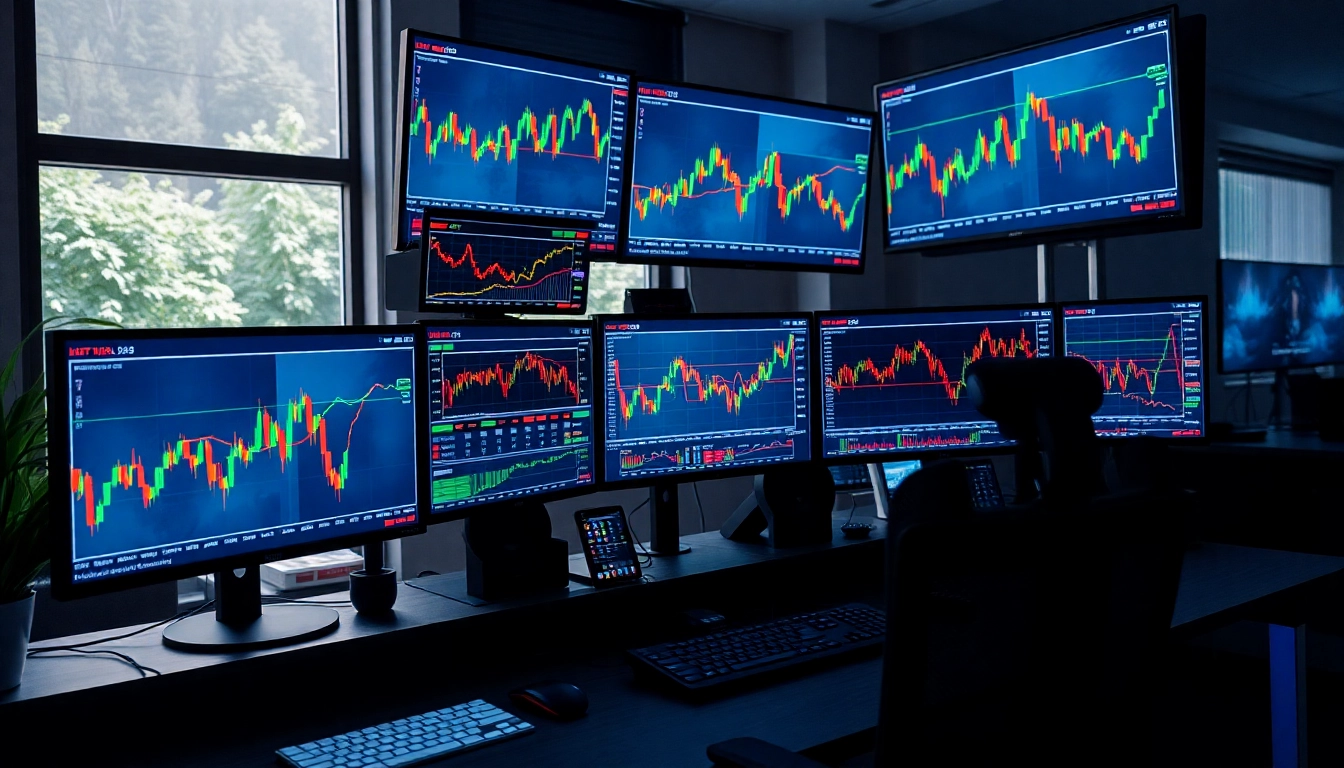Unlocking the Power of Trading View: A Comprehensive Guide for Traders of All Levels
In the fast-paced world of financial markets, having access to reliable, versatile, and comprehensive charting tools is essential for successful trading. Among the myriad platforms available today, trading view stands out as a leader, widely adopted by beginners and seasoned professionals alike. Its robust features, combined with a vibrant social trading community, make it an invaluable asset in anyone’s trading arsenal. This guide aims to delve deeply into the core functionalities of Trading View, explore strategies for effective usage, and provide advanced tips to help you maximize your trading performance.
Understanding the Core Features of Trading View
Charting Tools and Customization Options
At the heart of Trading View lies its powerful and intuitive charting platform. It offers an extensive array of technical analysis tools that enable traders to visualize market data comprehensively. Users can choose from multiple chart types—candlestick, bar, line, area, and more—tailored to their analytical preferences.
Further customization is a standout aspect, allowing traders to modify chart aesthetics, add drawing tools such as trendlines, Fibonacci retracements, and channels to identify key market levels. The platform supports multiple timeframes—from one-minute intraday charts to monthly long-term views—empowering traders to observe short-term fluctuations or long-term trends with equal ease.
Trading View’s scripting language, Pine Script, provides users the ability to develop custom indicators and trading algorithms, fostering a personalized trading environment that aligns precisely with individual strategies.
Social Trading and Community Insights
One of Trading View’s unique strengths is its social component. Traders can share ideas, comment, and analyze charts collectively through community ideas and public publications. This feature democratizes market insights—allowing newcomers to learn from experts and veterans to gauge sentiment across diverse assets.
The social aspect fosters a collaborative trading environment, where discussions often include detailed analysis, strategy breakdowns, and real-time reactions to market movements. This collective intelligence helps traders develop more nuanced perspectives and enhances decision-making.
Market Data and Real-Time Alerts Integration
Access to real-time, multi-market data is crucial for timely trading decisions. Trading View integrates live prices from global stock exchanges, cryptocurrencies, forex pairs, commodities, and indices, all within a single interface. Users can customize watchlists for quick access to preferred assets and receive instant alerts based on price levels, technical indicators, or news updates.
This real-time data connectivity ensures that traders are always informed of market shifts, enabling swift responses to emerging opportunities or risks. The platform’s alert system can be tailored to send notifications via SMS, email, or in-app alerts, facilitating active monitoring even when traders are multitasking or away from their desks.
Implementing Effective Trading Strategies with Trading View
Technical Analysis Techniques for Beginners
Beginners often start by mastering fundamental technical analysis concepts—mainly, trend identification, support and resistance levels, and volume analysis. Trading View simplifies this process through its user-friendly interface and pre-built indicators like Moving Averages, RSI, MACD, and Bollinger Bands.
For instance, recognizing a bullish breakout above resistance levels or confirming oversold conditions with RSI helps in making informed buy or sell decisions. Regular practice with live data on Trading View charts accelerates learning, enabling beginners to identify patterns and market signals confidently.
Using Indicators and Drawing Tools to Identify Trends
In addition to standard indicators, advanced traders leverage drawing tools to mark trendlines, identify channels, and acknowledge key chart patterns such as head and shoulders or double tops/bottoms. Combining these visual cues with technical indicators enhances the accuracy of trend analysis.
For example, drawing an ascending trendline along successive higher lows can confirm an uptrend, while divergence between price and technical indicators like MACD might signal a reversal. The ability to annotate, save, and share these chart setups within Trading View’s platform streamlines the strategizing process.
Backtesting Strategies for Better Performance
Backtesting involves testing trading strategies against historical data to evaluate potential profitability. Trading View’s Pine Script allows traders to script their own strategies and visually assess their effectiveness over past market conditions.
This process helps identify optimal entry and exit points, refine indicator settings, and eliminate emotional biases from trading plans. By integrating backtesting into routine analysis, traders can develop robust, data-backed strategies that improve consistency and overall performance.
Advanced Tips for Experienced Traders
Creating and Sharing Trading Ideas
Experienced traders often build a reputation by publishing detailed trading ideas on Trading View. These ideas can include annotated charts, reasoning, and projections, fostering engagement with the community. Sharing insights not only enhances credibility but also opens doors to feedback and collaborative learning.
With features like version control and privacy settings, traders can gradually build a portfolio of public or private ideas, experimenting with different strategies and gathering valuable insights from peer analysis.
Automation and Alerts Customization
Automation allows traders to eliminate manual monitoring, thereby reducing emotional imperfections. Trading View supports setting up complex alerts based on various conditions, such as crossing specific price levels, indicator signals, or pattern formations.
Advanced users leverage webhook integrations to connect Trading View alerts with third-party trading platforms or automation scripts, creating semi-automated or fully automated trading workflows.
Optimizing Your Watchlists and Portfolio Tracking
Creating well-organized watchlists tailored to your trading universe improves efficiency. Categorizing assets by asset class, volatility, or trading style allows quick access and monitoring.
Additionally, portfolio tracking features within Trading View afford traders a snapshot of their current positions, profit/loss metrics, and risk exposure—facilitating disciplined, data-driven decisions that align with your overall trading plan.
Integrating Trading View into Your Trading Routine
Mobile and Desktop App Usage for On-the-Go Analysis
Flexibility is crucial in modern trading. Trading View’s mobile apps (available on iOS and Android) and desktop version ensure seamless access regardless of location. Traders can analyze charts, modify positions, and receive alerts on the move, maintaining agility in dynamic markets.
Using these tools in tandem allows for a continuous monitoring setup, where insights gained on one device synchronize across all platforms, making real-time trades more efficient.
Syncing Data Across Devices for Seamless Trading
Synchronization is imperative for maintaining consistency in your analysis. Trading View’s cloud-based architecture keeps your watchlists, drawing annotations, strategies, and alerts synchronized across multiple devices, reducing redundancy and errors.
Building a Consistent Trading Workflow with Trading View
A systematic trading routine involves regular chart analysis, journaling trades, and reviewing performance metrics. Trading View supports this by integrating various analytical tools, alerts, and social features into a cohesive workflow that can be customized to your trading style.
Measuring Success and Improving Your Trading Performance
Analyzing Chart Data and Trading History
Post-trade analysis is vital for continuous improvement. Trading View offers trade logging and historical chart playback, enabling traders to review past decisions, assess strategy efficacy, and identify biases or recurring mistakes.
This reflective process should be part of your routine, helping you refine your approach based on objective data rather than intuition alone.
Utilizing Community Ideas for Market Insights
Community ideas serve as a barometer of market sentiment and provide real-world trading scenarios. By examining popular ideas, traders can learn new analytical techniques or gauge market consensus on specific assets, enriching their decision-making toolkit.
Tracking Key Metrics to Enhance Strategy Effectiveness
Successful traders monitor performance metrics like win rate, profit factor, maximum drawdown, and expectancy. Setting up personalized dashboards within Trading View to track these KPIs helps in making informed adjustments to strategies, aiming for consistent profitability.



